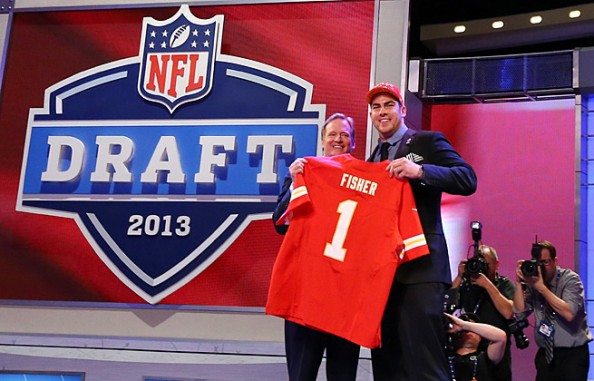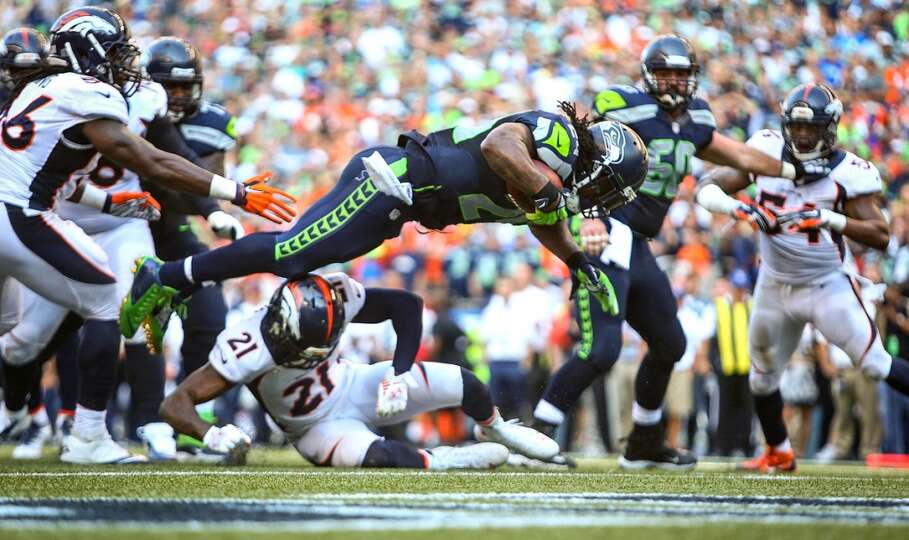
Russell Okung is entering the final year of his rookie contract in 2015
The Seahawks have several prospective free agents in 2016 including punter Jon Ryan, running back Robert Turbin and the current longest serving player on the roster Brandon Mebane. Three other starters are set to make the open market — Bruce Irvin, J.R. Sweezy and Russell Okung.
Today I want to focus on Okung.
Firstly, can he play a full 16 games in the regular season? His injury issues are slightly exaggerated — he hasn’t had a serious knee injury for example or missed considerable time like Ryan Clady. The most games he’s missed in a single season is eight in 2013. He’s consistently missed 1-5 games each year since arriving in Seattle. Not ideal, but far from a reason alone not to give him a new contract.
If he can feature in all 16 games for the first time in his career in 2015, he’ll really strengthen his hand going into free agency. The Seahawks will perhaps feel inclined to try and maintain some consistency on their offensive line (more on that in a moment) while other teams will be reassured to give him a good contract to tempt him away.
If he misses more time it strengthens Seattle’s position at the negotiating table and might weaken interest on the open market. For that reason the Seahawks are probably prepared to let this year play out rather than get into serious negotiations right now.
Aside from the health situation, how does Okung rate compared to his peers in the NFL? Joe Thomas (25), Tyron Smith (36), Jason Peters (40) and Trent Williams (47) were the only offensive tackles listed in the NFL’s recent top-100 list. We’re going through an era that lacks truly elite left tackles in the Walter Jones, Orlando Pace and Jonathan Ogden mould. The game has changed and for years the best athletes in college football have chosen to play defense not offense. It’s one of the reasons why the Seahawks are taking SPARQ-ed up D-liners and trying them at guard. Pure college guards are generally no longer athletic enough to transition to the pro’s where they face increasingly formidable athletes. Any left tackle that performs admirably at the combine is getting vaulted up the boards — it’s why Eric Fisher was the #1 overall pick in 2013.
The number of first round busts at the position also appears to be increasing. Fisher has been a big disappointment. Luke Joeckel — the #2 pick in 2013 — has struggled with injury and performance. 2014 top-ten picks Greg Robinson and Jake Matthews didn’t have great rookie seasons. What was once considered a ‘safe pick’ has become more of an unknown.
The league is craving for good offensive tackles. Teams are taking chances. It’s becoming a bit of a crapshoot considering the third tackle taken in 2013 — Lane Johnson — has enjoyed a good start to his career.
If Thomas, Smith, Peters and Williams really are the NFL’s current ‘elite’ at the position, Okung isn’t far away. Although he might be some way off the Hall-of-Fame tackle he replaced in Seattle, Okung is a relative safe pair of hands that might be difficult to replace with a cheaper, unknown commodity in the draft. In an era without many fantastic left tackles, having a good one might be more valuable than you’d imagine.
Okung is the only consistent member of Pete Carroll, John Schneider and Tom Cable’s offensive line. Left guard, center, right guard and right tackle — different players have taken turns to start for Seattle over the years. 2016 will provide the first opportunity to see how they approach the left tackle position and whether they see that as a movable cog too. Okung was the first draft pick this front office made when they arrived in 2010. He’s played out his rookie contract in full. Do they let him walk? Or do they see him as part of the growing core to receive a contract extension?
While teams like Dallas and Cleveland load their offensive lines with first round talent the Seahawks seem to be taking the opposite approach. They appear to be saving money on the O-line to use elsewhere. It’s a display of trust in Tom Cable’s methods that he can put a group of guys together on the cheap and create a functioning line. We’ve seen mixed results so far, but the constant change on a year-to-year basis is partly responsible there.
It makes you wonder if they believe they can succeed without top players on the O-line in a way others can’t. After all, they were winning games with Paul McQuistan and Michael Bowie playing tackle in 2013 — the season they won the Super Bowl. It made for ugly viewing at times with pass protection particularly suffering. The Seahawks might feel like they have enough weapons to compensate for any similar problems in 2015:
— Russell Wilson is the most elusive quarterback in the NFL
— The ground game continues to prosper
— Jimmy Graham’s presence will give Wilson an easy out and keep defenses honest when it comes to the blitz/pass rush
— The threat of the read option adds a dynamic to Seattle’s offense that also troubles opponents
Other teams don’t necessarily have this luxury. The Cowboys have Dez Bryant but also a 35-year-old quarterback with back issues who isn’t very mobile and needs protection. They are hoping their offensive line can be the key to a productive running game with either Joseph Randle or Darren McFadden benefitting from good blocking. They don’t have Marshawn Lynch and a good running quarterback so a really good offensive line is more important.
The Wilson-Lynch-Graham trifecta will create problems and will make plays irrespective of the performance of the offensive line. The downside is we’ll probably see more games next year where Wilson is having to move around a lot to avoid pressure.
Sometimes you have to pick your poison.
With the Seahawks paying nearly $100m to just ten players on their roster, they need to save money somewhere. It could be they’ve decided in Cable they have a coach that, like Alex Gibbs previously, can get the most out of a group of blockers. That in part helps you keep the LOB, Wilson, Lynch, Wagner etc.
That doesn’t mean they can’t pay any offensive linemen. We’ll see how far they want to take this possible plan when Okung and J.R. Sweezy head closer to free agency next year. Mark Glowinski in terms of athleticism and style looks like a Sweezy clone and he’s being worked at right guard in training camp. Danny O’Neil mentioned yesterday that the Seahawks have a lot of time for Gary Gilliam as a left tackle prospect and could see him as a possible replacement for Okung one day.
Some fans will cringe at the possibility of a 2016 starting offensive line that goes Gilliam-Bailey-Nowak-Glowinski-Britt. Yet the willingness to trade Max Unger this year shows they aren’t afraid to make an eyebrow-raising move or two on the O-line or go with a youth movement. They’re willing to take chances on young, cheap talent. They brought in a collection of young players in the draft to compete this year. And again, they need to save money somewhere.
Tom Cable might be viewed as the MVP of the offensive line, rather than any particular player.
They’ve also shown they’re still willing to draft O-liners early (see: Justin Britt, round two in 2014). In my final 2015 mock draft I had them taking Mitch Morse in round two. He was taken a few picks before Seattle’s choice by the Kansas City Chiefs. Who knows if he would’ve been the pick otherwise — but he certainly ticked a lot of boxes.
Laremy Tunsil (T, Ole Miss), Taylor Decker (T, Ohio State), Ronnie Stanley (T, Notre Dame) and Jack Conklin (T, Michigan State) are early favourites to go in the first round next year. Decker in particular has that nasty road-grading style that appears to suit Seattle’s offense. Tackles tend to go early, whether the Seahawks will have the chance to get anywhere near a top blocker in 2016 remains to be seen. They could have options though.
One dynamic that should also be considered is the competitive nature of Okung, the respect he commands in the locker room and his recent decision to go into free agency minus an agent. He completes a six-year, $48.5m contract in 2015 so he’s already earned the money a lot of his teammates are now collecting.
That’s not to say he’s going to accept a really cheap deal to stay in Seattle. Far from it. But he will be negotiating from a position of relative security. If he wants to stay a Seahawk and if the team wishes to retain his services — there’s probably a deal to be done there. We just don’t know how invested each party is in retaining this current working relationship.
Another thing O’Neil mentioned in the link above is the possibility Okung might be better suited to a more pass-friendly offense focused on protection. Seattle’s physical style and penchant for the run-game could be one of the reasons their left tackle (and other members of the O-line) frequently gets banged up. Will a different style of offense suit Okung? It might be something he’s considering.
Of Seattle’s three ‘big name’ 2016 free agents, it’ll possibly be easier to retain Okung and Sweezy over Bruce Irvin. There’s a statistical advantage that comes with playing defense (I got 6-7 sacks last year playing linebacker, look what I could do in your scheme). He’s versatile enough to work in the 4-3 or the 3-4 at end or linebacker. Aside from one four-game suspension he’s stayed clear of any off-field distractions that concerned some teams pre-draft. He’s still a terrific athlete. And there are two former Seahawks defensive coordinators now working as Head Coaches.
If Irvin departs it leaves even more room to consider signing up Okung and/or Sweezy. The cap likely increasing by another 7-8% also helps. Overall that looks like an attractive proposition — retain some consistency up front, keep your depth and free up the opportunity to consider other need areas in the draft (DT, CB, RB).







